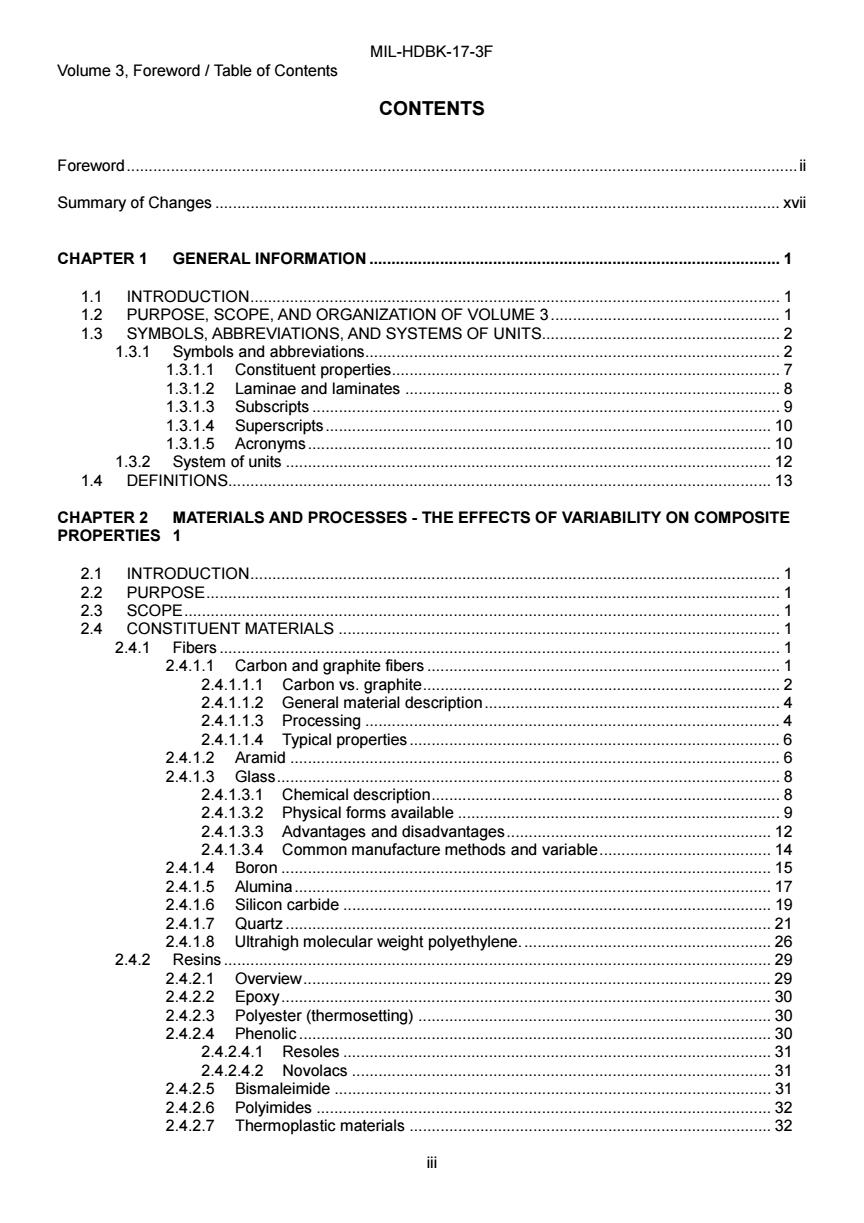
MIL-HDBK-17-3F Volume 3,Foreword Table of Contents CONTENTS Foreword Summary of Changes.… .xvii CHAPTER 1 GENERAL INFORMATION....... 1 1.1 NTRODUCTON 1.2 PURPOSE,SCOPE,AND ORGANIZATION OF VOLUME 3. 1 1.3 SYMBOLS,ABBREVIATIONS,AND SYSTEMS OF UNITS. .2 1.3.1 Symbols and abbreviations............... 2 1.3.1.1 Constituent properties... 1.3.1.2 Laminae and laminates. 8 1.3.1.3 Subscripts........ 9 1.3.1.4 Superscripts.... 10 1.3.1.5 Acronyms.… 10 1.3.2 System of units.... 12 1.4 DEFINITIONS........ 13 CHAPTER 2 MATERIALS AND PROCESSES-THE EFFECTS OF VARIABILITY ON COMPOSITE PROPERTIES 2.1 INTRODUCTION........ 1 2.2 PURPOSE 44444404444404 1 2.3 SCOPE... 1 2.4 CONSTITUENT MATERIALS 1 2.4.1 Fibers... 2.4.1.1 Carbon and graphite fibers............. 1 2.4.1.1.1 Carbon vs.graphite...... 2 2.4.1.1.2 General material description. .4 2.4.1.1.3 Processing.… 4 2.4.1.1.4 Typical properties.. ,6 2.4.1.2 Aramid..... 6 2.4.1.3 Glass 8 2.4.1.3.1 Chemical description.... 8 2.4.1.3.2 Physical forms available......... 9 2.4.1.3.3 Advantages and disadvantages................ 12 2.4.1.3.4 Common manufacture methods and variable..... 14 2.4.1.4 Bopon.... 15 2.4.1.5 Alumina.... 17 2.4.1.6 Silicon carbide. 19 2.4.1.7 Quartz......... 21 2.4.1.8 Ultrahigh molecular weight polyethylene. 26 2.4.2 29 RSl门S.................... 2.4.2.1 Overview..… 29 2.4.2.2 Epoxy.... 30 2.4.2.3 Polyester(thermosetting) 30 2.4.2.4 Phenolic....... 2.4.2.4.1 Resoles..... 3 2.4.2.4.2 NoV0aCs… 31 2.4.2.5 Bismaleimide................... 31 2.4.2.6 Polyimides............ 32 2.4.2.7 Thermoplastic materials 3 分
MIL-HDBK-17-3F Volume 3, Foreword / Table of Contents iii CONTENTS Foreword........................................................................................................................................................ii Summary of Changes ................................................................................................................................ xvii CHAPTER 1 GENERAL INFORMATION ............................................................................................. 1 1.1 INTRODUCTION........................................................................................................................ 1 1.2 PURPOSE, SCOPE, AND ORGANIZATION OF VOLUME 3.................................................... 1 1.3 SYMBOLS, ABBREVIATIONS, AND SYSTEMS OF UNITS...................................................... 2 1.3.1 Symbols and abbreviations.............................................................................................. 2 1.3.1.1 Constituent properties........................................................................................ 7 1.3.1.2 Laminae and laminates ..................................................................................... 8 1.3.1.3 Subscripts .......................................................................................................... 9 1.3.1.4 Superscripts..................................................................................................... 10 1.3.1.5 Acronyms......................................................................................................... 10 1.3.2 System of units .............................................................................................................. 12 1.4 DEFINITIONS........................................................................................................................... 13 CHAPTER 2 MATERIALS AND PROCESSES - THE EFFECTS OF VARIABILITY ON COMPOSITE PROPERTIES 1 2.1 INTRODUCTION........................................................................................................................ 1 2.2 PURPOSE.................................................................................................................................. 1 2.3 SCOPE....................................................................................................................................... 1 2.4 CONSTITUENT MATERIALS .................................................................................................... 1 2.4.1 Fibers ............................................................................................................................... 1 2.4.1.1 Carbon and graphite fibers ................................................................................ 1 2.4.1.1.1 Carbon vs. graphite................................................................................. 2 2.4.1.1.2 General material description................................................................... 4 2.4.1.1.3 Processing .............................................................................................. 4 2.4.1.1.4 Typical properties.................................................................................... 6 2.4.1.2 Aramid ............................................................................................................... 6 2.4.1.3 Glass.................................................................................................................. 8 2.4.1.3.1 Chemical description............................................................................... 8 2.4.1.3.2 Physical forms available ......................................................................... 9 2.4.1.3.3 Advantages and disadvantages............................................................ 12 2.4.1.3.4 Common manufacture methods and variable....................................... 14 2.4.1.4 Boron ............................................................................................................... 15 2.4.1.5 Alumina............................................................................................................ 17 2.4.1.6 Silicon carbide ................................................................................................. 19 2.4.1.7 Quartz .............................................................................................................. 21 2.4.1.8 Ultrahigh molecular weight polyethylene......................................................... 26 2.4.2 Resins ............................................................................................................................ 29 2.4.2.1 Overview.......................................................................................................... 29 2.4.2.2 Epoxy............................................................................................................... 30 2.4.2.3 Polyester (thermosetting) ................................................................................ 30 2.4.2.4 Phenolic ........................................................................................................... 30 2.4.2.4.1 Resoles ................................................................................................. 31 2.4.2.4.2 Novolacs ............................................................................................... 31 2.4.2.5 Bismaleimide ................................................................................................... 31 2.4.2.6 Polyimides ....................................................................................................... 32 2.4.2.7 Thermoplastic materials .................................................................................. 32
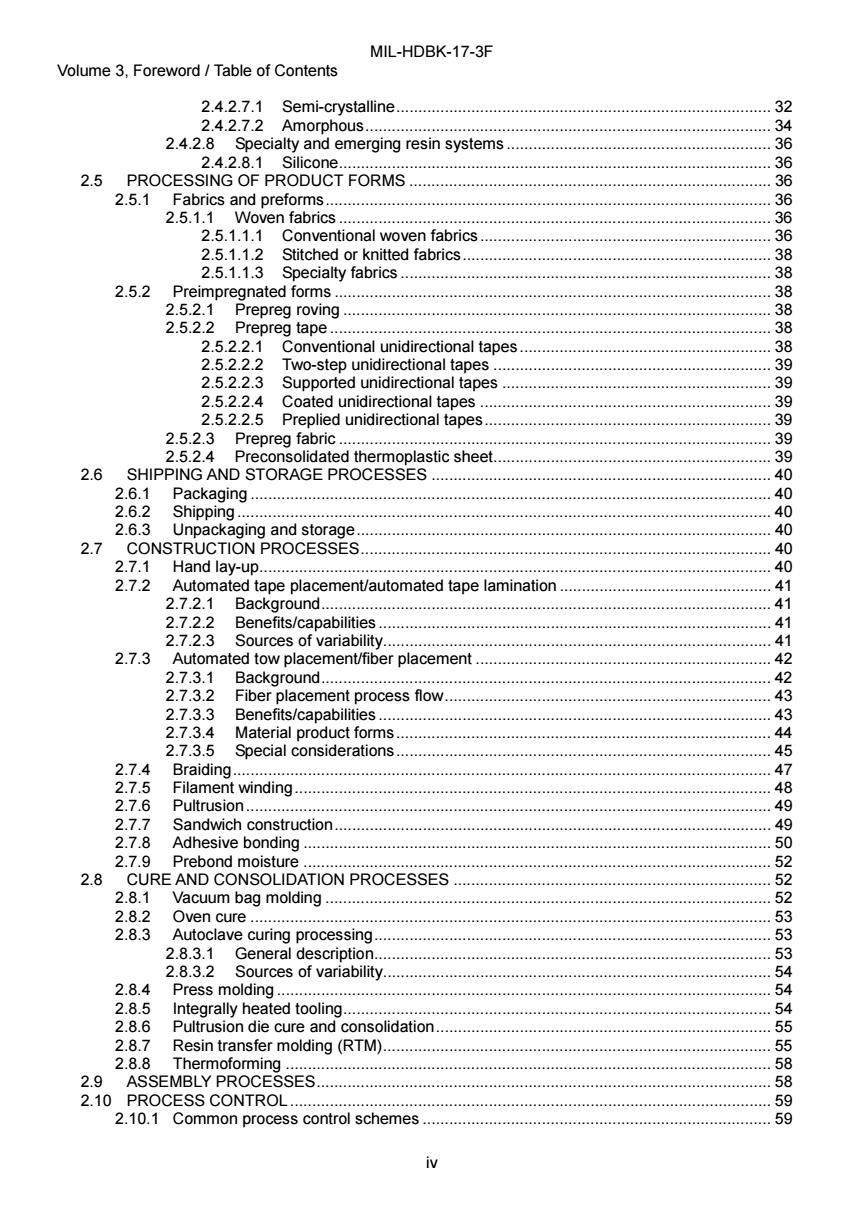
MIL-HDBK-17-3F Volume 3.Foreword Table of Contents 2.4.2.7.1 Semi-crystalline..... ,32 2.4.2.7.2 Amorphous........... 34 2.4.2.8 Specialty and emerging resin systems.......... .36 2.4.2.8.1 Silicone... 36 2.5 PROCESSING OF PRODUCT FORMS.................... 36 2.5.1 Fabrics and preforms..36 2.5.1.1 Woven fabrics... 6 2.5.1.1.1 Conventional woven fabrics.. 36 25.1.1.2 Stitched or knitted fabrics....... 38 2.5.1.1.3 Specialty fabrics..38 2.5.2 Preimpregnated forms.38 2.5.2.1 Prepreg roving… 8 2.5.2.2 Prepreg tape.......... 38 2.5.2.2.1 Conventional unidirectional tapes....................38 2.5.2.2.2 Two-step unidirectional tapes............... .39 2.5.2.2.3 Supported unidirectional tapes.39 2.5.2.2.4 Coated unidirectional tapes.... 39 2.5.2.2.5 Preplied unidirectional tapes. 39 2.5.2.3 Prepreg fabric. 39 2.5.2.4 Preconsolidated thermoplastic sheet..... 39 26 SHIPPING AND STORAGE PROCESSES.................................................. 40 2.6.1 Packaging.… 40 2.6.2 Shipping....... 40 2.6.3 Unpackaging and storage........ 40 2.7 CONSTRUCTION PROCESSES 40 2.7.1 Hand lay-up. 40 2.7.2 Automated tape placement/automated tape lamination.... 41 2.7.2.1 Background....... 41 2.7.2.2 Benefits/capabilities. 41 2.7.2.3 Sources of variability........ 41 2.7.3 Automated tow placement/fiber placement.......................... 42 2.7.3.1 Background..... 42 2.7.3.2 Fiber placement process flow................. 43 2.7.3.3 Benefits/capabilities... 43 2.7.3.4 Material product forms. 44 2.7.3.5 Special considerations 2.7.4 2.7.5 Braiding. > Filament winding..... 48 2.7.6 Pultrusion............... 49 2.7.7 Sandwich construction........ 49 2.7.8 Adhesive bonding.. 50 2.7.9 Prebond moisture ......... 52 2.8 CURE AND CONSOLIDATION PROCESSES ..52 2.8.1 Vacuum bag molding...52 2.8.2 Oven cure.… 53 2.8.3 Autoclave curing processing................ 53 2.8.3.1 General description.. 53 2.8.3.2 Sources of variability............ 54 2.8.4 Press molding 54 2.8.5 Integrally heated tooling........ 54 2.8.6 Pultrusion die cure and consolidation..... 55 2.8.7 Resin transfer molding (RTM)..................... 55 2.8.8 Thermoforming.... 58 2.9 ASSEMBLY PROCESSES..... 58 2.10 PROCESS CONTROL............ 59 2.10.1 Common process control schemes............. 59 iv
MIL-HDBK-17-3F Volume 3, Foreword / Table of Contents iv 2.4.2.7.1 Semi-crystalline..................................................................................... 32 2.4.2.7.2 Amorphous............................................................................................ 34 2.4.2.8 Specialty and emerging resin systems ............................................................ 36 2.4.2.8.1 Silicone.................................................................................................. 36 2.5 PROCESSING OF PRODUCT FORMS .................................................................................. 36 2.5.1 Fabrics and preforms..................................................................................................... 36 2.5.1.1 Woven fabrics .................................................................................................. 36 2.5.1.1.1 Conventional woven fabrics.................................................................. 36 2.5.1.1.2 Stitched or knitted fabrics...................................................................... 38 2.5.1.1.3 Specialty fabrics .................................................................................... 38 2.5.2 Preimpregnated forms ................................................................................................... 38 2.5.2.1 Prepreg roving ................................................................................................. 38 2.5.2.2 Prepreg tape .................................................................................................... 38 2.5.2.2.1 Conventional unidirectional tapes......................................................... 38 2.5.2.2.2 Two-step unidirectional tapes ............................................................... 39 2.5.2.2.3 Supported unidirectional tapes ............................................................. 39 2.5.2.2.4 Coated unidirectional tapes .................................................................. 39 2.5.2.2.5 Preplied unidirectional tapes................................................................. 39 2.5.2.3 Prepreg fabric .................................................................................................. 39 2.5.2.4 Preconsolidated thermoplastic sheet............................................................... 39 2.6 SHIPPING AND STORAGE PROCESSES ............................................................................. 40 2.6.1 Packaging ...................................................................................................................... 40 2.6.2 Shipping......................................................................................................................... 40 2.6.3 Unpackaging and storage.............................................................................................. 40 2.7 CONSTRUCTION PROCESSES............................................................................................. 40 2.7.1 Hand lay-up.................................................................................................................... 40 2.7.2 Automated tape placement/automated tape lamination ................................................ 41 2.7.2.1 Background...................................................................................................... 41 2.7.2.2 Benefits/capabilities ......................................................................................... 41 2.7.2.3 Sources of variability........................................................................................ 41 2.7.3 Automated tow placement/fiber placement ................................................................... 42 2.7.3.1 Background...................................................................................................... 42 2.7.3.2 Fiber placement process flow.......................................................................... 43 2.7.3.3 Benefits/capabilities ......................................................................................... 43 2.7.3.4 Material product forms..................................................................................... 44 2.7.3.5 Special considerations..................................................................................... 45 2.7.4 Braiding.......................................................................................................................... 47 2.7.5 Filament winding............................................................................................................ 48 2.7.6 Pultrusion....................................................................................................................... 49 2.7.7 Sandwich construction................................................................................................... 49 2.7.8 Adhesive bonding .......................................................................................................... 50 2.7.9 Prebond moisture .......................................................................................................... 52 2.8 CURE AND CONSOLIDATION PROCESSES ........................................................................ 52 2.8.1 Vacuum bag molding ..................................................................................................... 52 2.8.2 Oven cure ...................................................................................................................... 53 2.8.3 Autoclave curing processing.......................................................................................... 53 2.8.3.1 General description.......................................................................................... 53 2.8.3.2 Sources of variability........................................................................................ 54 2.8.4 Press molding ................................................................................................................ 54 2.8.5 Integrally heated tooling................................................................................................. 54 2.8.6 Pultrusion die cure and consolidation............................................................................ 55 2.8.7 Resin transfer molding (RTM)........................................................................................ 55 2.8.8 Thermoforming .............................................................................................................. 58 2.9 ASSEMBLY PROCESSES....................................................................................................... 58 2.10 PROCESS CONTROL ............................................................................................................. 59 2.10.1 Common process control schemes ............................................................................... 59
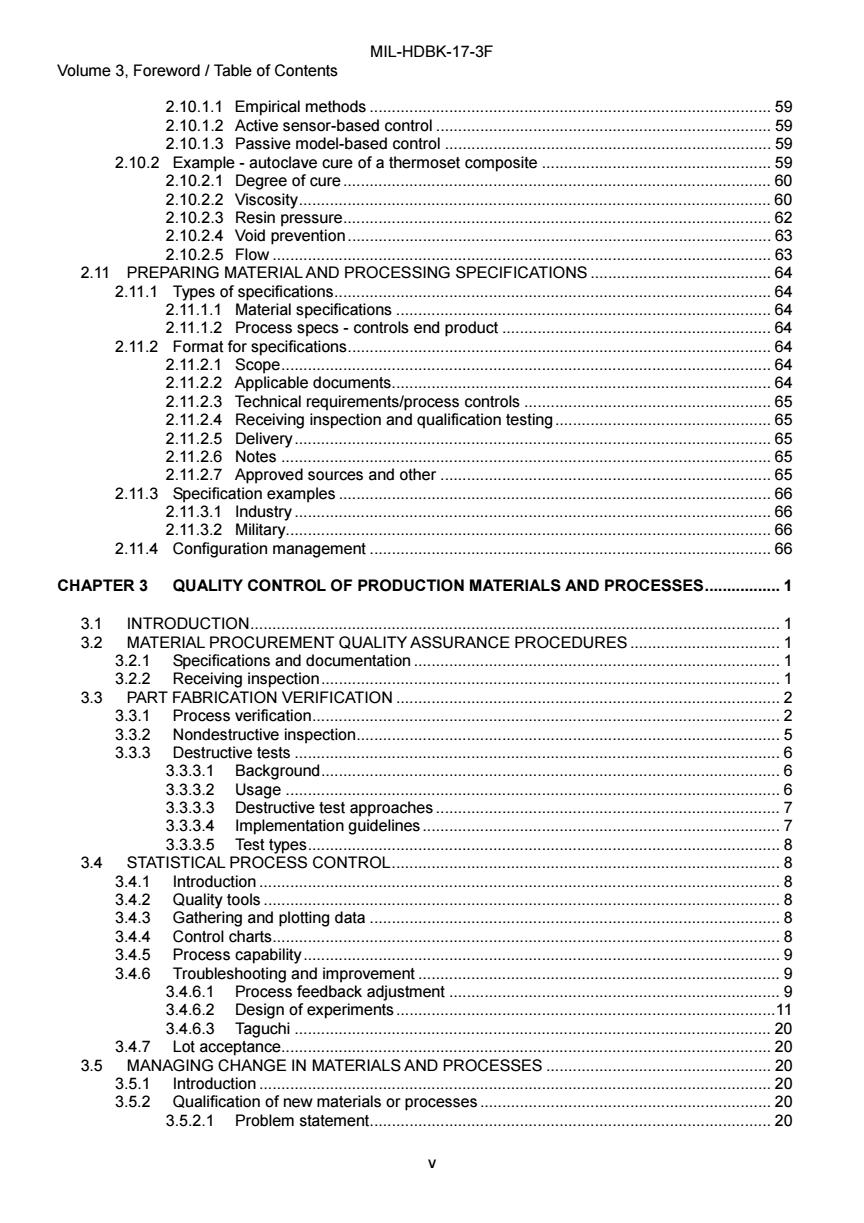
MIL-HDBK-17-3F Volume 3.Foreword Table of Contents 2.10.1.1 Empirical methods... 2.10.1.2 Active sensor-based control................... 59 59 2.10.1.3 Passive model-based control.59 2.10.2 Example-autoclave cure of a thermoset composite............ 59 2.10.2.1 Degree of cure............... 60 2.10.22 VSCOSity..60 2.10.2.3 Resin pressure............ .62 2.10.2.4 Void prevention. 63 2.10.2.5Flow. 63 2.11 PREPARING MATERIAL AND PROCESSING SPECIFICATIONS......................................6.4 2.11.1 Types of specifications.........64 2.11.1.1 Material specifications... 4 2.11.1.2 Process specs controls end product.. 64 2.11.2 Format for specifications.................. .64 2.11.2.1Sc0pe.… .64 2.11.2.2 Applicable documents........... 2.11.2.3 Technical requirements/process controls...... .64 65 2.11.2.4 Receiving inspection and qualification testing........................................... 65 2.11.2.5 Delivery.65 2.11.2.6 Notes.… .65 2.11.2.7 Approved sources and other..65 2.11.3 Specification examples ... .66 2.11.3.1 Industry.… 66 2.11.3.2 Military....... .66 2.11.4 Configuration management....... .66 CHAPTER 3 QUALITY CONTROL OF PRODUCTION MATERIALS AND PROCESSES.................1 3.1 INTRODUCTION................. .1 3.2 MATERIAL PROCUREMENT QUALITY ASSURANCE PROCEDURES................................1. 3.2.1 Specifications and documentation.............. 1 3.2.2 Receiving inspection. 3.3 PART FABRICATION VERIFICATION... ,2 3.3.1 Process verification.................. 2 3.3.2 Nondestructive inspection. 3.3.3 Destructive tests.… .6 3.3.3.1 Background6 3.3.3.2 Usage .. 3.3.3.3 Destructive test approaches.... 7 3.3.3.4 Implementation guidelines.... .7 3.3.3.5 Test types... 8 3.4 STATISTICAL PROCESS CONTROL. .8 3.4.1 Introduction.… 3.4.2 .8 Quality tools. .8 3.4.3 Gathering and plotting data................. .8 3.4.4 Control charts..... 3.4.5 Process capability....... .8 9 3.4.6 Troubleshooting and improvement....... 3.4.6.1 Process feedback adjustment........ …9 9 3.4.6.2 Design of experiments1 3.4.6.3 Taguchi..... 20 3.4.7 Lot acceptance...... 20 3.5 MANAGING CHANGE IN MATERIALS AND PROCESSES................................. 20 3.5.1 Introduction............. .20 3.5.2 Qualification of new materials or processes....... 20 3.5.2.1 Problem statement.... .20
MIL-HDBK-17-3F Volume 3, Foreword / Table of Contents v 2.10.1.1 Empirical methods ........................................................................................... 59 2.10.1.2 Active sensor-based control ............................................................................ 59 2.10.1.3 Passive model-based control .......................................................................... 59 2.10.2 Example - autoclave cure of a thermoset composite .................................................... 59 2.10.2.1 Degree of cure................................................................................................. 60 2.10.2.2 Viscosity........................................................................................................... 60 2.10.2.3 Resin pressure................................................................................................. 62 2.10.2.4 Void prevention................................................................................................ 63 2.10.2.5 Flow ................................................................................................................. 63 2.11 PREPARING MATERIAL AND PROCESSING SPECIFICATIONS ......................................... 64 2.11.1 Types of specifications................................................................................................... 64 2.11.1.1 Material specifications ..................................................................................... 64 2.11.1.2 Process specs - controls end product ............................................................. 64 2.11.2 Format for specifications................................................................................................ 64 2.11.2.1 Scope............................................................................................................... 64 2.11.2.2 Applicable documents...................................................................................... 64 2.11.2.3 Technical requirements/process controls ........................................................ 65 2.11.2.4 Receiving inspection and qualification testing................................................. 65 2.11.2.5 Delivery............................................................................................................ 65 2.11.2.6 Notes ............................................................................................................... 65 2.11.2.7 Approved sources and other ........................................................................... 65 2.11.3 Specification examples .................................................................................................. 66 2.11.3.1 Industry ............................................................................................................ 66 2.11.3.2 Military.............................................................................................................. 66 2.11.4 Configuration management ........................................................................................... 66 CHAPTER 3 QUALITY CONTROL OF PRODUCTION MATERIALS AND PROCESSES................. 1 3.1 INTRODUCTION........................................................................................................................ 1 3.2 MATERIAL PROCUREMENT QUALITY ASSURANCE PROCEDURES .................................. 1 3.2.1 Specifications and documentation ................................................................................... 1 3.2.2 Receiving inspection........................................................................................................ 1 3.3 PART FABRICATION VERIFICATION ....................................................................................... 2 3.3.1 Process verification.......................................................................................................... 2 3.3.2 Nondestructive inspection................................................................................................ 5 3.3.3 Destructive tests .............................................................................................................. 6 3.3.3.1 Background........................................................................................................ 6 3.3.3.2 Usage ................................................................................................................ 6 3.3.3.3 Destructive test approaches .............................................................................. 7 3.3.3.4 Implementation guidelines................................................................................. 7 3.3.3.5 Test types........................................................................................................... 8 3.4 STATISTICAL PROCESS CONTROL........................................................................................ 8 3.4.1 Introduction ...................................................................................................................... 8 3.4.2 Quality tools ..................................................................................................................... 8 3.4.3 Gathering and plotting data ............................................................................................. 8 3.4.4 Control charts................................................................................................................... 8 3.4.5 Process capability............................................................................................................ 9 3.4.6 Troubleshooting and improvement .................................................................................. 9 3.4.6.1 Process feedback adjustment ........................................................................... 9 3.4.6.2 Design of experiments......................................................................................11 3.4.6.3 Taguchi ............................................................................................................ 20 3.4.7 Lot acceptance............................................................................................................... 20 3.5 MANAGING CHANGE IN MATERIALS AND PROCESSES ................................................... 20 3.5.1 Introduction .................................................................................................................... 20 3.5.2 Qualification of new materials or processes.................................................................. 20 3.5.2.1 Problem statement........................................................................................... 20
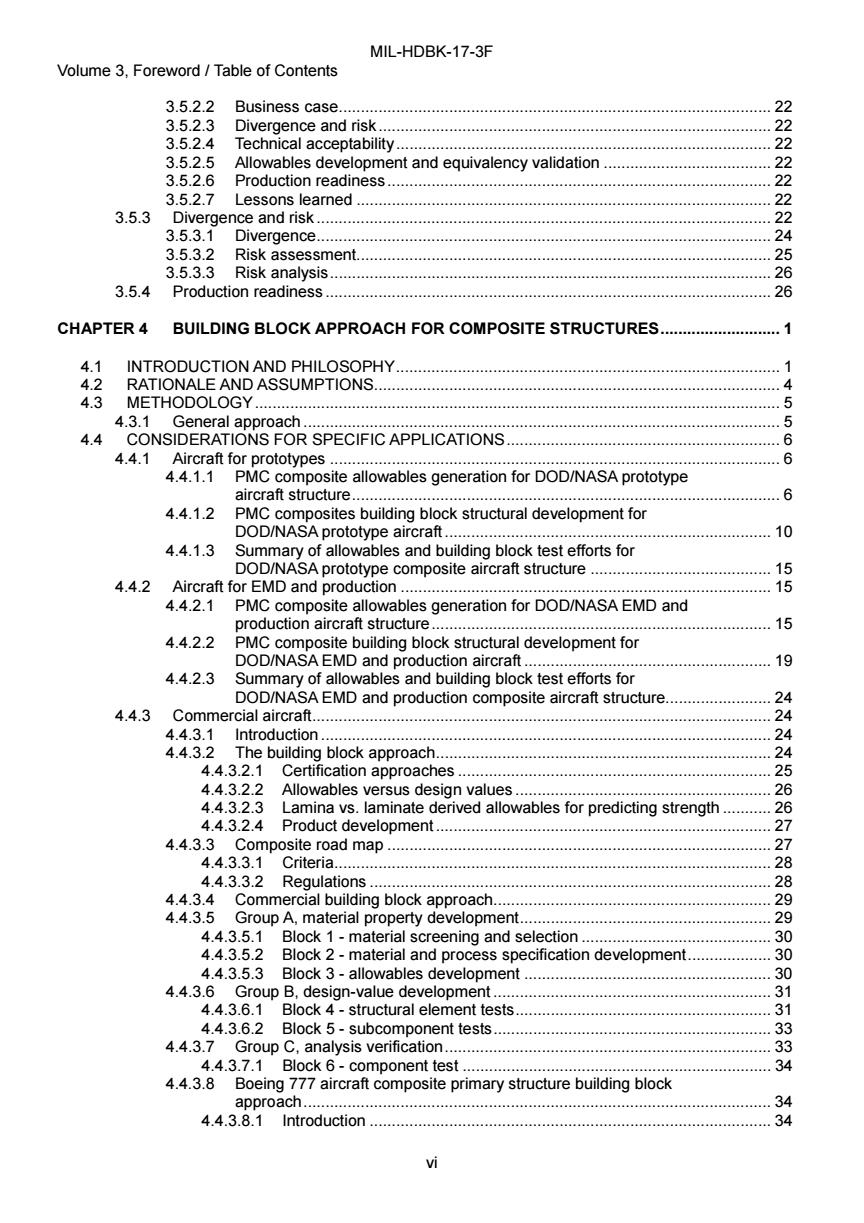
MIL-HDBK-17-3F Volume 3.Foreword Table of Contents 3.5.2.2 Business case.... 22 3.5.2.3 Divergence and risk... 22 3.5.2.4 Technical acceptability22 3.5.2.5 Allowables development and equivalency validation ........................... 22 3.5.2.6 Production readiness................... 22 3.5.2.7 Less0 ns learned… 22 3.5.3 Divergence and risk............. 22 3.5.3.1 Divergence.......... 24 3.5.3.2 Risk assessment............... 25 3.5.3.3 Risk analysis.. 4.4...... 26 3.5.4 Production readiness...... 26 CHAPTER 4 BUILDING BLOCK APPROACH FOR COMPOSITE STRUCTURES.... 1 4.1 INTRODUCTION AND PHILOSOPHY.......... 1 4.2 RATIONALE AND ASSUMPTIONS................... 4 4.3 METHODOLOGY.......... .5 4.3.1 General approach... 5 4.4 CONSIDERATIONS FOR SPECIFIC APPLICATIONS.......................................... 6 4.4.1 Aircraft for prototypes ................ 0.6 4.4.1.1 PMC composite allowables generation for DOD/NASA prototype aircraft structure....... .6 4.4.1.2 PMC composites building block structural development for DOD/NASA prototype aircraft........ 10 4.4.1.3 Summary of allowables and building block test efforts for DOD/NASA prototype composite aircraft structure................15 4.4.2 Aircraft for EMD and production...... .15 4.4.2.1 PMC composite allowables generation for DOD/NASA EMD and production aircraft structure.. 15 4.4.2.2 PMC composite building block structural development for DOD/NASA EMD and production aircraft.......... .19 4.4.2.3 Summary of allowables and building block test efforts for DOD/NASA EMD and production composite aircraft structure.................4 4.4.3 Commercial aircraft................ 24 4.4.3.1 Introduction… 24 4.4.3.2 The building block approach....24 4.4.3.2.1 certification approaches................. .25 4.4.3.2.2 Allowables versus design values..... 26 4.4.3.23 Lamina vs.laminate derived allowables for predicting strength...........26 4.4.3.2.4 Product development27 4.4.3.3 Composite road map......... 27 4.4.3.3.1 Criteria.… 28 4.4.3.3.2 Regulations.… 28 4.4.3.4 Commercial building block approach..29 4.4.3.5 Group A,material property development...... .29 4.4.3.5.1 Block 1-material screening and selection..... 30 4.4.3.5.2 Block 2-material and process specification development................... 30 4.4.3.5.3 Block 3-allowables development ,30 4.4.3.6 Group B,design-value development...........31 4.4.3.6.1 Block 4-structural element tests.......................31 4.4.3.6.2 Block 5-subcomponent tests. 33 4.4.3.7 Group C,analysis verification... 33 4.4.3.7.1 Block 6-component test.34 4.4.3.8 Boeing 777 aircraft composite primary structure building block approach. 34 4.4.3.8.1 Introduction................ 34
MIL-HDBK-17-3F Volume 3, Foreword / Table of Contents vi 3.5.2.2 Business case.................................................................................................. 22 3.5.2.3 Divergence and risk......................................................................................... 22 3.5.2.4 Technical acceptability..................................................................................... 22 3.5.2.5 Allowables development and equivalency validation ...................................... 22 3.5.2.6 Production readiness....................................................................................... 22 3.5.2.7 Lessons learned .............................................................................................. 22 3.5.3 Divergence and risk ....................................................................................................... 22 3.5.3.1 Divergence....................................................................................................... 24 3.5.3.2 Risk assessment.............................................................................................. 25 3.5.3.3 Risk analysis.................................................................................................... 26 3.5.4 Production readiness..................................................................................................... 26 CHAPTER 4 BUILDING BLOCK APPROACH FOR COMPOSITE STRUCTURES........................... 1 4.1 INTRODUCTION AND PHILOSOPHY....................................................................................... 1 4.2 RATIONALE AND ASSUMPTIONS............................................................................................ 4 4.3 METHODOLOGY....................................................................................................................... 5 4.3.1 General approach ............................................................................................................ 5 4.4 CONSIDERATIONS FOR SPECIFIC APPLICATIONS.............................................................. 6 4.4.1 Aircraft for prototypes ...................................................................................................... 6 4.4.1.1 PMC composite allowables generation for DOD/NASA prototype aircraft structure................................................................................................. 6 4.4.1.2 PMC composites building block structural development for DOD/NASA prototype aircraft .......................................................................... 10 4.4.1.3 Summary of allowables and building block test efforts for DOD/NASA prototype composite aircraft structure ......................................... 15 4.4.2 Aircraft for EMD and production .................................................................................... 15 4.4.2.1 PMC composite allowables generation for DOD/NASA EMD and production aircraft structure............................................................................. 15 4.4.2.2 PMC composite building block structural development for DOD/NASA EMD and production aircraft ........................................................ 19 4.4.2.3 Summary of allowables and building block test efforts for DOD/NASA EMD and production composite aircraft structure........................ 24 4.4.3 Commercial aircraft........................................................................................................ 24 4.4.3.1 Introduction ...................................................................................................... 24 4.4.3.2 The building block approach............................................................................ 24 4.4.3.2.1 Certification approaches ....................................................................... 25 4.4.3.2.2 Allowables versus design values .......................................................... 26 4.4.3.2.3 Lamina vs. laminate derived allowables for predicting strength ........... 26 4.4.3.2.4 Product development ............................................................................ 27 4.4.3.3 Composite road map ....................................................................................... 27 4.4.3.3.1 Criteria................................................................................................... 28 4.4.3.3.2 Regulations ........................................................................................... 28 4.4.3.4 Commercial building block approach............................................................... 29 4.4.3.5 Group A, material property development......................................................... 29 4.4.3.5.1 Block 1 - material screening and selection ........................................... 30 4.4.3.5.2 Block 2 - material and process specification development................... 30 4.4.3.5.3 Block 3 - allowables development ........................................................ 30 4.4.3.6 Group B, design-value development ............................................................... 31 4.4.3.6.1 Block 4 - structural element tests.......................................................... 31 4.4.3.6.2 Block 5 - subcomponent tests............................................................... 33 4.4.3.7 Group C, analysis verification.......................................................................... 33 4.4.3.7.1 Block 6 - component test ...................................................................... 34 4.4.3.8 Boeing 777 aircraft composite primary structure building block approach.......................................................................................................... 34 4.4.3.8.1 Introduction ........................................................................................... 34
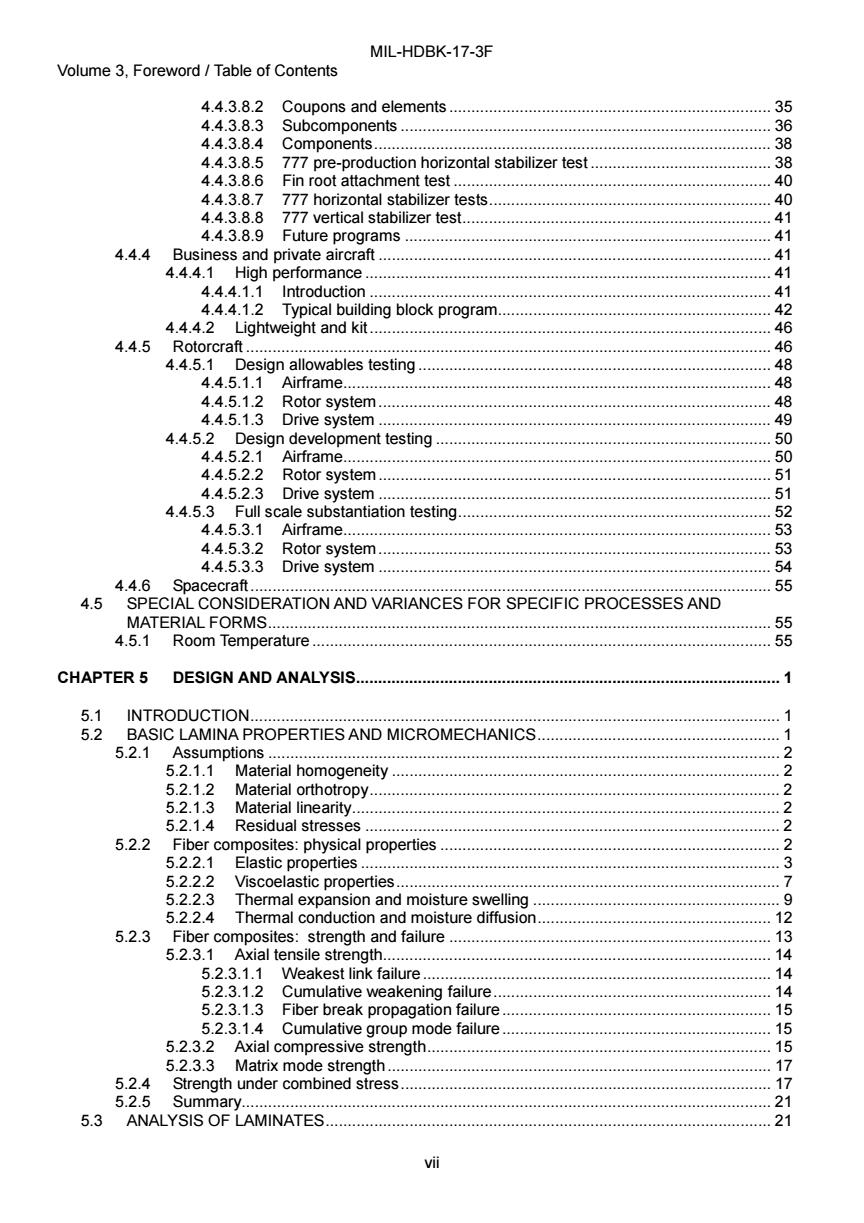
MIL-HDBK-17-3F Volume 3.Foreword Table of Contents 4.4.3.8.2 Coupons and elements........ 4.4.3.8.3 Subcomponents.… 35 36 4.4.3.8.4 Components... 38 4.4.3.8.5 777 pre-production horizontal stabilizer test................................. 38 4.4.3.86 Fin root attachment test................. 40 4.4.3.8.7 777 horizontal stabilizer tests..40 4.4.3.8.8 777 vertical stabilizer test............. 41 4.4.3.8.9 Future programs. 41 4.4.4 Business and private aircraft............... 41 4.4.4.1 High performance.... .41 4.4.4.1.1 Introduction... 41 4.4.4.1.2 Typical building block program.... 4 4.4.4.2 Lightweight and kit. 46 46 4.4.5 Rotorcratt............................................................................................. 4.4.5.1 Design allowables testing.............. 48 4.4.5.1.1 Airframe...48 4.4.5.1.2 Rotor system..... 48 4.4.5.1.3 Drive system ....................... 49 4.4.5.2 Design development testing. ,50 4.4.5.2.1 Airframe.............. .50 4.4.5.2.2 Rotor SyStem....51 4.4.5.2.3 Drive system... 51 4.4.5.3 Full scale substantiation testing.... 52 4.4.5.3.1 Airframe..… .53 4.4.5.3.2 Rotor system.................... 53 4.4.5.3.3 Drive system. 54 4.4.6 Spacecraft.… .55 4.5 SPECIAL CONSIDERATION AND VARIANCES FOR SPECIFIC PROCESSES AND MATERIAL FORMS...........................55 4.5.1 Room Temperature................... .55 CHAPTER 5 DESIGN AND ANALYSIS.... 1 5.1 INTRODUCTION........ .1 5.2 BASIC LAMINA PROPERTIES AND MICROMECHANICS... 5.2.1 Assumptions .............. 2 5.2.1.1 Material homogeneity 5.2.1.2 Material orthotropy........... 5.2.1.3 Material linearity................... 2 5.2.1.4 Residual stresses............................. 5.2.2 Fiber composites:physical properties...... 2 2 5.2.2.1 Elastic properties... 5.2.2.2 > Viscoelastic properties.. 5.2.2.3 Thermal expansion and moisture swelling.........................................9 5.2.2.4 Thermal conduction and moisture diffusion..... 12 5.2.3 Fiber composites:strength and failure......... .13 5.2.3.1 Axial tensile strength.................................... 14 5.2.3.1.1 Weakest link failure14 5.2.3.1.2 Cumulative weakening failure.............. .14 5.2.3.1.3 Fiber break propagation failure...............................15 5.2.3.1.4 Cumulative group mode failure. 15 5.2.3.2 Axial compressive strength............................ 15 5.2.3.3 Matrix mode strength.. 17 5.2.4 Strength under combined stress...................... …17 5.2.5 Summary21 5.3 ANALYSIS OF LAMINATES........ .21 vii
MIL-HDBK-17-3F Volume 3, Foreword / Table of Contents vii 4.4.3.8.2 Coupons and elements ......................................................................... 35 4.4.3.8.3 Subcomponents .................................................................................... 36 4.4.3.8.4 Components.......................................................................................... 38 4.4.3.8.5 777 pre-production horizontal stabilizer test ......................................... 38 4.4.3.8.6 Fin root attachment test ........................................................................ 40 4.4.3.8.7 777 horizontal stabilizer tests................................................................ 40 4.4.3.8.8 777 vertical stabilizer test...................................................................... 41 4.4.3.8.9 Future programs ................................................................................... 41 4.4.4 Business and private aircraft ......................................................................................... 41 4.4.4.1 High performance ............................................................................................ 41 4.4.4.1.1 Introduction ........................................................................................... 41 4.4.4.1.2 Typical building block program.............................................................. 42 4.4.4.2 Lightweight and kit........................................................................................... 46 4.4.5 Rotorcraft ....................................................................................................................... 46 4.4.5.1 Design allowables testing ................................................................................ 48 4.4.5.1.1 Airframe................................................................................................. 48 4.4.5.1.2 Rotor system......................................................................................... 48 4.4.5.1.3 Drive system ......................................................................................... 49 4.4.5.2 Design development testing ............................................................................ 50 4.4.5.2.1 Airframe................................................................................................. 50 4.4.5.2.2 Rotor system......................................................................................... 51 4.4.5.2.3 Drive system ......................................................................................... 51 4.4.5.3 Full scale substantiation testing....................................................................... 52 4.4.5.3.1 Airframe................................................................................................. 53 4.4.5.3.2 Rotor system......................................................................................... 53 4.4.5.3.3 Drive system ......................................................................................... 54 4.4.6 Spacecraft...................................................................................................................... 55 4.5 SPECIAL CONSIDERATION AND VARIANCES FOR SPECIFIC PROCESSES AND MATERIAL FORMS.................................................................................................................. 55 4.5.1 Room Temperature ........................................................................................................ 55 CHAPTER 5 DESIGN AND ANALYSIS................................................................................................ 1 5.1 INTRODUCTION........................................................................................................................ 1 5.2 BASIC LAMINA PROPERTIES AND MICROMECHANICS....................................................... 1 5.2.1 Assumptions .................................................................................................................... 2 5.2.1.1 Material homogeneity ........................................................................................ 2 5.2.1.2 Material orthotropy............................................................................................. 2 5.2.1.3 Material linearity................................................................................................. 2 5.2.1.4 Residual stresses .............................................................................................. 2 5.2.2 Fiber composites: physical properties ............................................................................. 2 5.2.2.1 Elastic properties ............................................................................................... 3 5.2.2.2 Viscoelastic properties....................................................................................... 7 5.2.2.3 Thermal expansion and moisture swelling ........................................................ 9 5.2.2.4 Thermal conduction and moisture diffusion..................................................... 12 5.2.3 Fiber composites: strength and failure ......................................................................... 13 5.2.3.1 Axial tensile strength........................................................................................ 14 5.2.3.1.1 Weakest link failure............................................................................... 14 5.2.3.1.2 Cumulative weakening failure............................................................... 14 5.2.3.1.3 Fiber break propagation failure............................................................. 15 5.2.3.1.4 Cumulative group mode failure............................................................. 15 5.2.3.2 Axial compressive strength.............................................................................. 15 5.2.3.3 Matrix mode strength....................................................................................... 17 5.2.4 Strength under combined stress.................................................................................... 17 5.2.5 Summary........................................................................................................................ 21 5.3 ANALYSIS OF LAMINATES..................................................................................................... 21